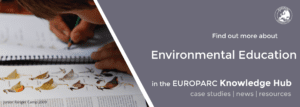#HabitatHeroes Pioneers from the Peak District National Park
The Peak District National Park in central England is full of diverse landscapes and home to many rare species. It is for example the only place in England where mountain hares can be found. Read about how the Habitat Heroes are looking after the Park’s natural treasure.
Meet our #HabitatHeroes: Junior Rangers of the Peak District National Park
The Peak District National Park runs six Junior Ranger groups. They collected comments from different participants across the different groups and merged them into one case study for the Habitat Heroes campaign.
Tell us all about your “natural treasure”: Which is the species or habitat you learn and work with the most in your Protected Area?
The Peak District landscape is full of natural treasures! In the south of the park, the limestone geology creates amazing rock formations, caves, and provides perfect soil for hay meadows rich in wildflowers. In the North, there are bogs and heather moorland. The heather turns the whole hills purple in summer, and the moorland vegetation makes ideal nesting conditions for ground nesting birds like curlews and grouse.
The park is surrounded by cities so there is a lot of pressure on our natural environment, so it’s important to take care of it!
We are also very lucky to have populations of mountain hares – the only place in England they can be found! These are different from brown hares as they change colour in winter, their fur turning white for camouflage.
The moorlands are a very sensitive environment, and are often damaged by fire (including a hige one last summer that burned for three weeks), so it’s very important that we look after them. In the valleys across the park, there are ancient woodlands, home to many rare bird and plant species.
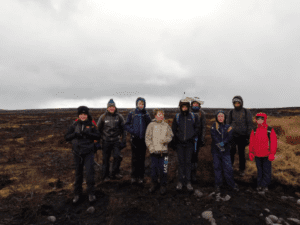
Junior Rangers exploring the moorland in the Peak District National Park
What are you and your fellow Junior Rangers doing (or will do) to learn more and protect your natural treasure? Do you also teach others?
In the Peak District we have 6 junior ranger groups. Our work varies depending on location, as there are different habitats in the different parts of the park! We all learn practical conservation tasks, as well as navigation and bushcraft skills, and help engage other people with the park at events.
Longdendale Junior rangers group have our own woodland area to look after; this year we have planted new trees, coppiced old ones and have built benches using recycled railway sleepers. We have also helped run a community event in the woodlands for local families, running activities such as minibeast hunting and den building to share our knowledge.
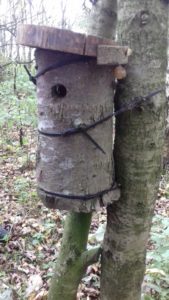
Willow Tit nest box, Junior Ranger Peak District.
We are also inspired by exploring the surrounding hills and moorlands: this year, we have taken expeditions on to the local moors to search for mountain hares, survey peat depth and vegetation, and see the damage caused by the Saddleworth Fire of 2018.
Next year, we’re hoping to build on our skills, with activities to include nest box building, dry stone walling and sphagnum moss planting to help the restoration of peat bogs. The group at Edale have already been working on replanting sphagnum plugs in their own area.
At Marsh Farm, our Junior Rangers group have been focused on helping the Willow Tit, a rare and declining bird that lives in the woodlands around the site. They have surveyed the birds, learnt more about their lives and built nest boxes lined with sawdust to attract them. Some of the nest boxes have been used this year, which is great news!
What do you find tricky being a Junior Ranger – and what is the best thing about it?
What do our Junior rangers find tricky? Some of them say they have found it difficult to balance their school work with coming out at weekends to be part of junior rangers, and others find that rural transport is difficult. Some of our older junior rangers have said they worry about where they will be able to go once they are too old for the groups, so we are looking at developing a follow-on group for young conservationists in the age 18-25.
Our Junior rangers think the best things about it are meeting other people like them, learning new skills and getting chance to explore!
Learn more and keep track of #HabitatHeroes campaign activities!
Since 2018 we are “mapping the field” and raising awareness for the great work Junior Ranger groups are currently doing for threatened flora, fauna and habitats in Protected Areas and Natura 2000 sites in particular.
- Visit the “Habitat Heroes” campaign website: For now, we are thrilled to introduce you to our Habitat Hero campaign pioneers – groups already taking action. You will find a growing map and overview of Junior Ranger groups.
- Besides, you will meet our “Habitat Heroes” in dedicated articles – make sure you follow our news!
- Keep an eye on social media – the #HabitatHeroes will provide you with exciting updates from our Junior Ranger groups that take part in the campaign. Don’t forget to share their actions!
Want to join the campaign? We are happy to learn about your conservation action – just drop us a mail: f.minozzi@europarc.org.
The new EU Commission. EUROPARC Federation is ready to serve!
Plenary Session- Presentation by the Commission President-elect of the College of Commissioners and their programme - Election of the Commission

Article issued by Ignace Schops
Yesterday, 27th of November, the European Parliament has elected the new European Commission for the next 5 years, led by Ursula von der Leyen. Read here how the new commissioners are willing to make it the “greenest EU Commission Europe has ever seen”.
Article issued by Ignace Schops, President of the EUROPARC Federation.
In her agenda for Europe “A Union that strives for more” EU President Ursula von der Leyen drafts her 6 headline ambitions and priorities for the next 5 years. With “A European Green Deal” the new EU President is determent what will be the “hallmark” for Europe. EU Commissioner Frans Timmermans will be her second-in-command and lead the European Green Deal.

Ursula von der Leyen by Arno Mikkor
With her team, Ursula will strive to become the first climate-neutral continent, which includes the creation of the first European Climate Law to enshrine the 2050 climate neutrality target into reality. And that’s not all! The new Green Deal includes the protection of Europe’s natural environment, biodiversity, food security, deforestation and land degradation as well.
A new Biodiversity Strategy 2030 will be presented and the EU will take the next step towards a circular economy. A new “Farm to Fork Strategy” on sustainable food along the whole value chain will be developed and President von der Leyen wants Europe to move towards a zero-pollution ambition.
We feel we are moving towards the right direction, towards the right side of development, towards the right side of humanity.
EUROPARC Federation is pleased with the Green Deal. EU President Ursula von der Leyen proposes an inclusive approach, based on the planetary boundaries.
As EUROPARC President, I welcome the EU president Ursula von der Leyen, the EU Vice-president Frans Timmermans, the EU Commissioner for the Environment Virginijus Sinkkevicius and all other Commissioners. EUROPARC Federation is ready to serve, looking forward to working with the EU, Commissioners, and Directorates!
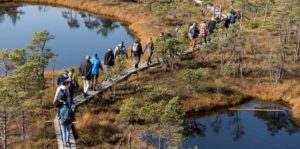
Kemeri National Park, EUROPARC Conference 2019, September 2019
Just a couple of months ago, we were all united in Kemeri National Park in Latvia for your annual conference. This year’s theme “Nature on our mind, understanding our values” was spot on! We could learn, exchange, disseminate our values and desires, our ambitions and opportunities. We highlighted our policy papers and we launched our “Healthy Parks, Healthy People Europe” initiative. But above all we were inspired by the wild wonders of nature and by the power we, as a network, can create. United. To protect, to preserve, to re-connect. Now and in the future.
I am so proud and honored to lead this beautiful federation. Let’s not destroy what keeps us alive! Think globally, act locally and change personally!
#HabitatHeroes Pioneers from the Biebrza National Park
Biebrza National Park in Poland protects one of the biggest fens in Europe. The Park’s Junior Ranger Programme runs since 2014 and until now remains the only one in the country. Read about how the Habitat Heroes from the Biebrza National Park help to protect their ‘natural treasure’ – the Biebrza river and its beautiful valley.
Meet our #HabitatHeroes: Junior Rangers of the Biebrza National Park
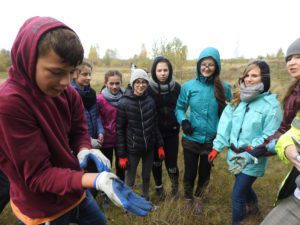
Junior Rangers of Biebrza National Park
Tell us all about your “natural treasure”: Which is the species or habitat you learn and work with the most in your Protected Area?
Our “natural treasure” is Biebrza river and its beautiful valley. The Biebrza National Park protects one of the biggest fens in Europe. The area is really huge, it covers 59 223 ha and is the largest national park in Poland. The Biebrza Wetlands are renowned throughout Europe as important breeding, feeding and stop over site for many waterfowl and wetland birds. For such endangered species as the aquatic warbler, spotted eagle or great snipe, the Biebrza Valley is one of the last remaining refuges in Europe. Over 270 species of birds were recorded here.
In Biebrza National Park, you can see how European lowland rivers looked like many years ago.
Biebrza is famous for a large number of elk (700 elks) and few wolf families living here, too. So, briefly about our „natural treasure”: little civilization, a lot of space and silence, silence, silence…
What is special about it?
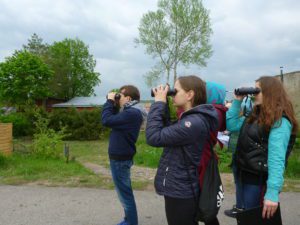
Biebrza National Park
We (participants and mentors of JR group) spend a lot of time on the river, because we have lived close to it since we were born. We love swimming in the river every summer. Some of the pupils are from farming families and they work in the meadows with their parents, e.g. to collect hay. Some boys, sometimes also girls like fishing. We love kayaking too.
We want to help to save this nature. Every year, we help amphibians during their spring migration. We take care of tourist routes and clean them. There are a lot of birds on Biebrza, our goal is to know them, so we learn to recognize species on every our trip.
We also learn about daily duties of park employees. In the past years (2016-2019), we have been helping with the removal of alien invasive plant species.
Describe to us what you and your fellow Junior Rangers are doing/will do to learn more and protect your natural treasure.
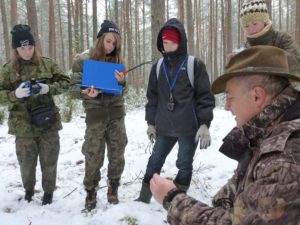
Biebrza National Park
„Know more” – every year we have 2-3 lectures with Park employees and 2-3 trips to the Park. These are outdoor learning combined with work, e.g. ornithological trip, or exploring flora. It is a good opportunity to do some practical nature conservation activities and to learn more about the Park.
We Save the Amphibians is a 5 weeks activity that takes place every spring time, since 2008.
Every spring, we save hundreds of amphibians from a death under the wheels of cars.
Biebrza NP protects amphibians on migration routes, using special hurdles, along the road near Goniądz. It helps to protect the animals from death under the wheels of cars. Every morning and evening Junior Rangers from Goniądz removed amphibians from the buckets and move them to the other side of the road. The number of rescued amphibians in 300 meters along the fen ranges from 200 to 5000 each season.
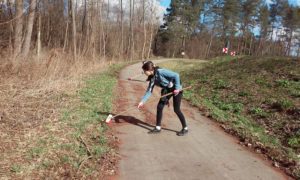
Source: Biebrza National Park
„Clean up the world”: we remove garbage on tourist routes on every our trip, clean the GreenVelo bike trail, sometimes we clean soldiers’ graves in the cemetery and in the forest, we paint fences on tourist routes, and wash education boards.
We remove and try to eliminate invasive species, growing near the tourist trail. In 2014 we focused on Robinia pseudoacatia, while in 2016 and 2018 on Impatiens parviflora.
We protect the Natura 2000 habitats. The last action (November 2019) consisted in the collection and removal of old branches and branches lying on thermophilic grasslands. They adversely affect the habitat, shading and causing changes in the species composition, and result in a loss of plants. We managed to clean a large area of grasslands around the Park’s tower.
Do you also teach others?
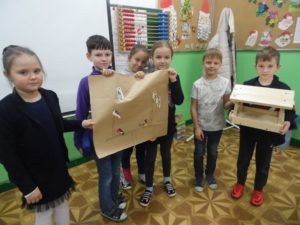
Biebrza National Park
We do educate others. Once a year, we prepare and conduct classes for kindergarten and our younger school friends, children aged 3-10 (approx. 100 pupils). There were events with different topics such as: Elk Day, Animal Tracks in the snow, and “We help birds in winter” campaign, in which we showed how to build feeders and how to feed birds.
For the 100 years of Polish Independence Day we organised an event for children „White-tailed eagle – our emblem“. We made a special small nature theatre for pre-schoolers. We work as animators at the educational stand at various educational picnics like: Wetland Day, Elk Run, Bee Day. It’s hard work, we work sometimes several hours as volunteers to assist in games for families with children.
As Junior Rangers, we try to accompany Park employees in their work.
Our Junior Rangers participate in monitoring of Pasque Flower Pulsatilla pratensis, Pulsatilla patens; moose and birds counting, and autumn insect searching.
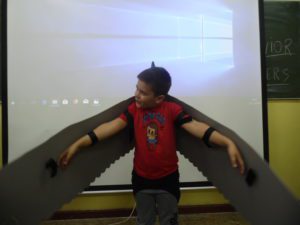
Biebrza National Park
Every year we have a 2-3 day Junior Rangers Camp in Biebrza National Park. In this year camp (May 2019), which was dedicated to protection of wild pollinating insects, we built 15 hotels for insects. Employees of the commune office put them to green places in our town, Goniądz.
We also joined a programme called School Safari 2019/2020. In the framework of this project, we organise activities like lottery, or baking Christmas elk gingerbreads for children in Tanzania.
More about Biebrza national Park
Our team consists of about 20-30 pupils from small city Goniądz, located on the river. Every year some new pupils join to JR Program. The Biebrza NP cooperates with the local school. The group has volunteer mentors – teacher Mrs Irmina Sosnowska and Ewa Wiatr from Biebrza NP. We have support from the municipal office, too – which provides a free bus for trips.Check the Park’s Facebook page to learn more.
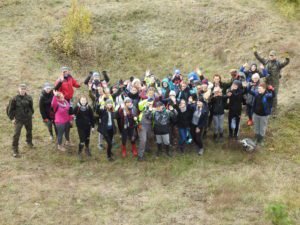
Junior Ranger Biebrza National Park
Learn more and keep track of #HabitatHeroes campaign activities!
Since 2018 we are “mapping the field” and raising awareness for the great work Junior Ranger groups are currently doing for threatened flora, fauna and habitats in Protected Areas and Natura 2000 sites in particular.
- Visit the “Habitat Heroes” campaign website: For now, we are thrilled to introduce you to our Habitat Hero campaign pioneers – groups already taking action. You will find a growing map and overview of Junior Ranger groups.
- Besides, you will meet our “Habitat Heroes” in dedicated articles – make sure you follow our news!
- Keep an eye on social media – the #HabitatHeroes will provide you with exciting updates from our Junior Ranger groups that take part in the campaign. Don’t forget to share their actions!
Want to join the campaign? We are happy to learn about your conservation action – just drop us a mail: f.minozzi@europarc.org
Grand opening of the Mobile Film Festival: ACT NOW on climate change
The 15th Mobile Film Festival (MFF) opened its ACT NOW edition in partnership with YouTube Creators for Change and United Nations Climate Change (UNFCCC). The online film festival is running from 14th to 30th of November and invites the public to watch the 50 selected films, coming from 24 countries.
ACT NOW on climate change!
Following the international call for 1 minute-long mobile films, the festival organizers received more than 800 films from 91 countries. It is a record for the MFF in terms of diversity.
Coming from 5 continents, both from big cities and the countryside, the directors have chosen to support the incredible youth movement initiated by Greta Thunberg, which brings together millions of people from all over the world.
Read more about the rules and goals of this Mobile Film Festival edition.
The Film Festival aims to support this movement through all kinds and genres of stories – be it joyful or sad, funny or absurd, promising or desperate. The genres represented in the selection include thriller, animation, documentary, science fiction…and particularly humor!
Those stories are intended for both young and old people. They challenge, question and raise awareness on the urgency to ACT NOW, in the face of climate change.
The 50 selected films from 24 countries cover 10 main topics such as waste, recycling, global warming, water scarcity, deforestation, youth activism, climate anticipation, small gestures, overpopulation and transportation.
In the first week from 16 to 24 November, the festival supports the European Week of Waste Reduction.
The MFF is running now, until the 30th November, presenting 50 films in competition on all social platforms and particularly on YouTube. Everyone is kindly invited to watch, comment and share in order to create more awareness on climate issues and to reach as many people as possible.
Throughout the year, the films will be presented online, at screenings in cultural centres, in festivals, cinemas, and by the Festival’s partners on social media.
